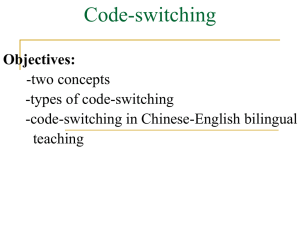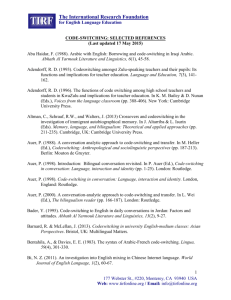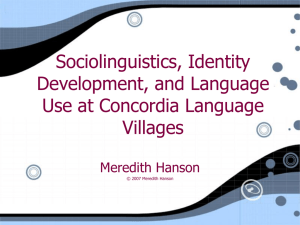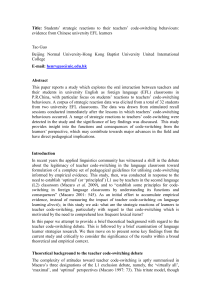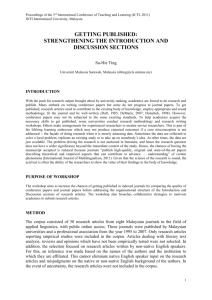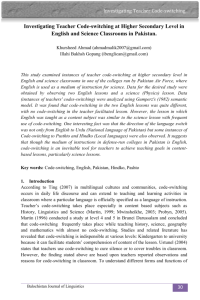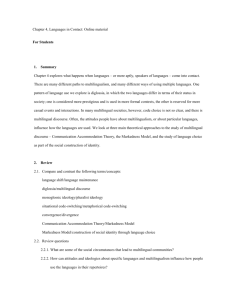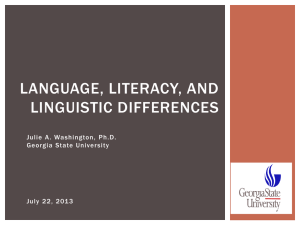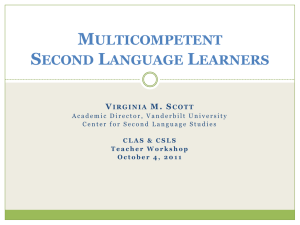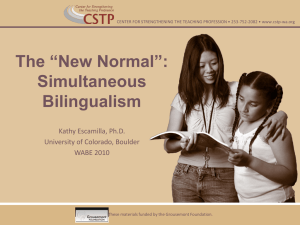File
advertisement
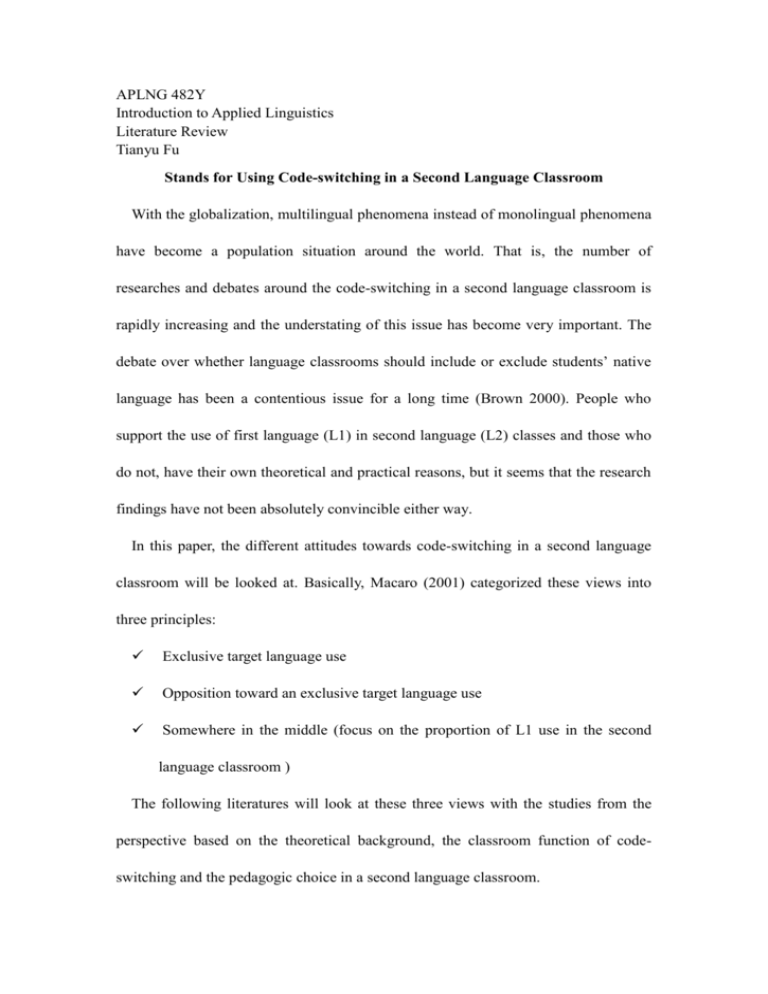
APLNG 482Y Introduction to Applied Linguistics Literature Review Tianyu Fu Stands for Using Code-switching in a Second Language Classroom With the globalization, multilingual phenomena instead of monolingual phenomena have become a population situation around the world. That is, the number of researches and debates around the code-switching in a second language classroom is rapidly increasing and the understating of this issue has become very important. The debate over whether language classrooms should include or exclude students’ native language has been a contentious issue for a long time (Brown 2000). People who support the use of first language (L1) in second language (L2) classes and those who do not, have their own theoretical and practical reasons, but it seems that the research findings have not been absolutely convincible either way. In this paper, the different attitudes towards code-switching in a second language classroom will be looked at. Basically, Macaro (2001) categorized these views into three principles: Exclusive target language use Opposition toward an exclusive target language use Somewhere in the middle (focus on the proportion of L1 use in the second language classroom ) The following literatures will look at these three views with the studies from the perspective based on the theoretical background, the classroom function of codeswitching and the pedagogic choice in a second language classroom. I. Exclusive target language use There are some scholars objecting to use L1 in L2 classes. According to Wei and Maritin (2009), “Whereas code-switching in community contexts is regarded as acceptable bilingual talk, in many classroom contexts code-switching is deemed inappropriate or unacceptable, and as deficit or dysfunctional mode of interaction” (Wei and Maritin, 2009), the conclusion here is that code-switching is often prohibited. Hobbs, Matsuo, and Payne then pointed that researchers who support this view may refer to Krashen’s proposal of “making use of comprehensive input as well as natural order of acquisition in foreign language classrooms” (Krashen, 1981), making the argument that “an exclusive use of the target language to enhance target language input to pupils” (Hobbs, Matsuo, and Payne, 2010). In 2012, Tian, & Macaro made a research aiming to find out that “is students’ receptive vocabulary learning better facilitated by a teacher’s use of code-switching or by providing L2-only information?” (Tian, &Macaro, 2012). They selected 117 participants who were first-year English-language majors in Chinese universities. Since these students were taught by different teachers previously, they took three tests before they were allocated to the three conditions, to reduce original teacher effect. And the stratification was based on the combined scores of a general English proficiency test involving reading, writing, vocabulary and grammar tests, a listening comprehension test and a baseline vocabulary test. Then in the following weeks all of these students were taught by the same bilingual teachers. The difference between the code-switching (CS) group and the non-code-switching (NCS) group was that in the CS condition, the teacher briefly switched to the Chinese in relation to the target lexical item while the NCS only received information of explanation of vocabulary in L2. Two weeks after the 6 weeks’ instructional intervention, there will be a test to exam the students’ learning outcome. The finding suggested that “Some benefits for teacher code-switching over remaining in L2 thereby being compelled to put across form-meaning relationships via definitions and paraphrases, but the beneficial effect was not huge). Therefore, the result showed that “there is no implication that teachers should constantly switch to L1 in order to provide the meanings of unfamiliar words” (Tian, &Macaro, 2012). This study was represented study to support the theories mentioned before and it is also consist with the claim made by Ellis et al. that “teachers and students could navigate in and out of focusing on aspects of the code while still keeping the overall orientation of the message intact” (Ellis et al, 2001). Also it supports a finding reported by Guo (2007) who did a study on teachers’ code-switching behaviors based one mainland China’s university EFL classroom. The participants in that study were first year non-English major undergraduate students ranging in age from 18 to 22. And the results also showed “no deleterious effect of the teacher mixing codes was reported by the students” (Guo, 2007). Studies used to support the exclusive use of target language in a second language classroom in this paper are all based on the research on the reaction or students’ performance towards two different teaching methods. And in most cases, the arguments are focus on the little influence or benefits for using code-switching in a second language class and these surveys provide a good reference and resource for teachers to retreat when they need to decide whether they will take a code-switching into their classroom. II. Support the use of code-switching in a second language classroom Secondly, a great portion of researchers advocate using L1 in theL2 classroom and their opinions are found under a range of themes. For example, Guthrie questioned “whether the fact that a lesson is conducted entirely in the L2 results in greater intake by learner” (Guthrie, 1984). “Exclusive use of the L2 is detrimental to the process of concept development by, at times, providing an obstacle to connecting with thoughts and ideas already developed in the L1” (Skinner, 1985). “The negative attitudes to first language expressed by pupils in their study (in English secondary schools) were likely to be, in part, a result of the unequal power relationships particularly prevalent in language classroom where the target language predominates” (Stable and Wikely, 1991). Most of their arguments are based on the discussion of negative influence brought by the only L2 used in a second language classroom. To support these ideas, there are numerous studies have been done to search for the function and benefits of taking code-switching as a pedagogical strategy. Ant´on and DiCamilla analyzed numerous conversational excerpts about how students carry out language tasks in pairs. And these showed that “students used the L1 to enlist and maintain each other’s interest in the task, develop strategies for making the task manageable, maintain their focus on the foal of the task, foreground important elements of the task…” (Ant´on & Dicamillia, 1999). Similarity, Swain and Lapkin did a study of the French adolescent learners in Canada. The participants were Grade Nine students who were in their first and only semester for French learning. From these participants, three groups were formed based on background information from the questionnaire—one group of 44 Grade 9 unilingual English speaking Canadian-born participants, a second group of 40 Grade 9 multilingual Canadian-born participants and a third group of 51 ESL participants (Swain and Lapkin, 2000). By observing instances of peer scaffolding and assistance received by the learner from a mentor or more knowledgeable peer in performing a range of tasks, they reached three level of classroom L1 use: “1) moving the task along, 2) focusing attention, and 3) interpersonal interaction” (Swain and Lapkin, 2000). By looking at different studies about examining the function of using L1 in L2 language classroom, Levine made a conclusion of L1 function as follow: From this brief look at the literature, the primary functions of L1 emerge: L1is used in dynamic ways for procedural communication, for establishing or maintaining control of the group, for reducing anxiety, for developing or maintaining inter subjectivity, and, of course, for explicit focus on grammatical forms or vocabulary for comprehension and /or learning. (Levine, 2014) Besides, L1 is regarded as a tool with different benefits to facilitate L2 learning in different scholars’ eyes: “L1 is a meditational tool fully available to learners, to regulate their own behavior, to focus attention on specific L2 structures, and to generate and assess alternatives” (Swain and Lapkin, 1998). Vygotsky (1978) regarded L1 as a cognitive tool, “which means language as a mediating tool in all forms of higher-order mental processing”. Learners may draw upon their L1 to “make sense of the world, new concepts, and a new language” (Cook, 2001). “L1 is also compared to a socio-cognitive tool, which is used to collect ideas that can in turn help mediate the learning of L2 and promote interaction among learners” (Thoms, 2005). Even though, there are various studies about how code-switching could work in a second language classroom, the results seem to be similar. That is code-switching would like to be used for managing and controlling the teaching and learning process, helping the problem solving, improving personal communicative interaction and it was a good tool for mediation. However, there are still two questions are under discussion in this field of attitude. First of all, studies and idea mentioned above are specifically focus on a much simplified the teaching environment that there is one sharing language either among students or between students and teachers. What if the classroom becomes more complex, and when the teacher is sharing the language with few students in the classroom, should he use code-switching too often? In another word, in this situation, is there an unfair in the classroom? Secondly, in English as Foreign Language (EFL) settings, how teachers could balance the use of L1 and L2 when doing the codeswitching? And sometime, if the teacher speaks too much L1, students will lack lots of opportunities to practice their L2 proficiency since mother tongue always makes them feel better than L2 and they would not willing to change. III. Views in the middle Thirdly, researchers who hold the idea somewhere in the middle struggled with the way of using code-switching. For example, Harbord saw “a humanistic need to switch from the L2 but advised against unbridled use of the L1 for fear of undermining the creative construct learning process” (Harbord, 1992).There was also a concern about “how restrict overuse of the L1 once the principle for its inclusion in the classroom has been accepted” (Gearon, 1998). Casrelloti in his articles also asked “If we should provide pedagogical principles for code-switching in the classroom” (Castellotti, 1998). Holding this questioning stance, several studies were made, indicating that the code-switching were used under a different situation for a different purpose in the language classroom. Raschka, Sercombe& Chi-Ling, in their article ‘conflicts and tensions in code-switching in a Taiwanese EFL classroom’ addressed that “there is an onus to indicate how CS can best serve the needs of EFL classroom participants, although many (teachers) seem to have an intuitive understanding of what works most appropriately” (Raschka, Sercombe& Chi-Ling, 2009). In their study, two classes were chosen from two different cram schools. One of them claimed to teach through the first language, while the other claimed to provide an “English-only” learning environment. All the students in this study were intermediate level students who were 16years of age or above. During a two-week period, there would be the whole classroom observations, detailed interviews with teachers and students and the recording of classroom interactions in each school. The findings by analyzing all data collection claimed that in both classes, teachers used code-switching as a pedagogical tool and the paper pointed out that “they (two teachers) switched between languages to produce the effects they desired in terms of socialization, topic switch, classroom management and metalinguistic functions” (Raschka, Sercombe& Chi-Ling, 2009. That indicated the unrealistic of English-only policy but also the author found that the use of CS “varied temporally within the discourse of each of the classrooms observed” (Raschka, Sercombe& Chi-Ling, 2009), which means, teachers would choose their ways of using code-switching based on their own teaching goals and preference. More studies were made to search specifically about when the pedagogical of code-switching is more useful. For example, there was a teaching tradition involving code-switching when the students were asked to carry out a certain task. According to Butzkamm, there is another teaching tradition prevailed in European international school excepts for the bilingual sections of German grammar schools “Here, some teachers have found it useful, after an initial presentation phase of new material, to give student groups some opportunity to clarify remaining problem among themselves and in their mother tongue” (Butzkamm,1998). Moreover, in the international school of Dusseldorf where all subjects are taught through English, “it is quite common for pupils with the same language background to do their homework collectively and again clarify problems in their L1” (Arth, 1966). Camilleri had done a research to look at language practices in secondary classrooms in Malta in general. One aim of his article was to explore when the codeswitching between Maltese and English normally taken by teachers and learners in constructing knowledge. And the study results showed a clear distinction about when L1 should be used and when L2 should be used. In their classroom conversations, the teachers and learners appeared to be continually attending to the symbolic values associated with Maltese and English. English was associated with formal, written discourse: It was a means of establishing distance between speakers, reader, and writer, and the use of English as a teaching medium discouraged participation by learner. In contrast, the use of Maltese created an informal atmosphere, established warmth and closeness between the participants, and encouraged participation and discussion on the part of the learner. (Camilleri, 1996). A strong view of L1 identity was reviewed from his study too and code-switching by the Maltese teachers in the classroom contexts considered not only as a communicative resource which can help to accomplish the lessons but also “a means of constructing specific professional identities: using enough English to appear “educated” but, at the same time, espousing a Maltese identity” (Camilleri, 1996). All the studies mentioned above are more practical which are focusing on when is a better situation to use the L1 and the different aim, function and effect of using L1 in a different situation. Also they are trying to depict a specific guide book for the teacher to refer to when they need to decide how to use code-switching properly in their own class. In a summary, this paper emphasizes on making a brief literature review of different attitudes towards the use of code-switching as a teaching method in a second language classroom. Studies used in the paper are more related to the effect of codeswitching in the second language acquisition area and as a result, the educational political requirements of certain teaching ways are not under consideration. The implication from above mentioned studies and attitudes is that researchers nowadays are not only focus on using specific research to support or deny the positive function of using the code-switching in a second language classroom but also are interested in making researches on searching the reasons and effects of using code-switching under special situations. Reference Antón, M., & DiCamilla, F. (1998). Socio-cognitive functions of L1 collaborative interaction in the L2 classroom. Canadian Modern Language Review/ La Revue Canadienne Des Langues Vivantes, 54(3), 314-342. Arth, I. (1966). Mathematik als bilinguals Sachfach (Staatsexamensarbeit), RWTH Aachen. Bickley, V. (ed). (1990) Language Use, Language Teaching and the Curriculum. Hong Kong: ILE. Brown H (2000). Principles of Language Learning and Teaching. Longman: San Francisco. Butzkamm, W. (1998). Code-switching in a bilingual history lesson: The mother tongue as a conversational lubricant. International Journal of Bilingual Education and Bilingualism, 1(2), 81-99. Camilleri, A. (1996). Language values and identities: Code switching in secondary classrooms in malta. Linguistics and Education, 8(1), 85-103. Castellotti,V. (1998). Langue étrangère et française en milieu scolaire: Didactiser l’alternance? [The foreign language and French in the school environment: A pedagogy for code-switching?]. Etudes de Linguistique Appliquée, 108,401-410. Cook,V (2001). Using the first language in the class room. Canadian Modern Language Review, 57, 402-423. Gearon, M. (1998). L’alternance entre I’anglaiset le français chez les professors de FLE en Australie. Etudes de Linguage Appliquée, 108, 467-474. Guo, T. (2007). A case study of teachers’ codeswitching behaviors in mainland China’s university EFL classrooms and students’ reactions to the code-switching. Unpublished doctoral dissertation, University of Oxford, UK. Guthrie, E. (1984). Intake, communication and second language learning. In J. Sauvifonon& M. Berns (Eds.), Initiatives in communicative language teaching, 35-45. Harbord, J. (1992). The use of the mother tongue in the classroom. ELT Journal, 46, 75-90. Hobbs, V., Matsuo, A., & Payne, M. (2010). Code-switching in Japanese language classrooms: An exploratory investigation of native vs. non-native speaker teacher practice. Linguistics and Education, 21(1), 44-59. Krashen, S.D. (1981). Second language acquisition and second language learning. Oxford, Uk: Pergamom. Levine, G. S. (2014). Principles for code choice in the foreign language classroom: A focus on grammaring. Language Teaching, 47(3), 332-348. Macaro, E. (2001). Analyzing student teachers’codeswitching in foreign language classrooms: Thesories and decision making. The modern Language Journal, 85(4), 531-548. Raschka, C., Sercombe, P., & Chi-Ling, H. (2009). Conflicts and tensions in codeswitching in a taiwanese EFL classroom. International Journal of Bilingual Education and Bilingualism, 12(2), 157-171. Skinner, D. (1985). Access to meaning: The anatomy of the language/ learning connection. Journal of Multilingual and Multicultural Development, 6 (5), 369389. Stables, A. &Wikely, F. (1999). From bad to worse? Pipils’ attitudes to modern foreign languages at ages 14-15. Language Learning Journal, 20, 27-31. Swain, M and Lapkin, S (1998). Interaction and second language learning: Two adolescent French immersion students working together. Modern Language Journal, 82 (3), 320-337. Swain, M. & S. Lapking (2000). Task-based second language learning: The uses of the first language. Language Teaching Research 4.3, 251-274. Szustak, A., Liao, J., & Thoms, J. (2005). The use of L1 in an L2 on-line chat activity. The Canadian Modern Language Review / La Revue Canadienne Des Langues Vivantes, 62(1), 161-182. Tian, L., &Macaro, E. (2012). Comparing the effect of teacher codeswitching with english-only explanations on the vocabulary acquisition of chinese university students: A lexical focus-on-form study. Language Teaching Research, 16(3), 367-391. Vygotsky L. S (1978). Mind in Society: The Development of Higher Psychological Processes. Cambridge: Harvard University Press. Wei, L., & Martin, P. (2009). Conflicts and tensions in classroom codeswitching: An introduction. International Journal of Bilingual Education and Bilingualism, 12(2), 117-122.
